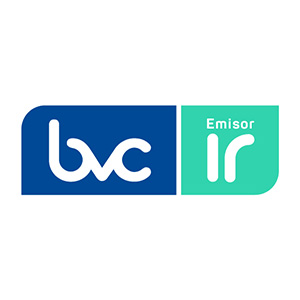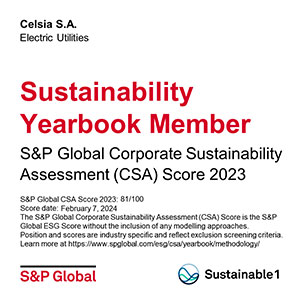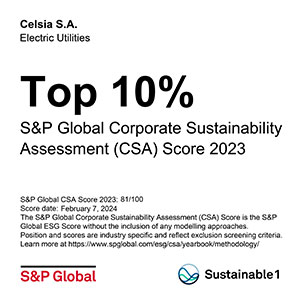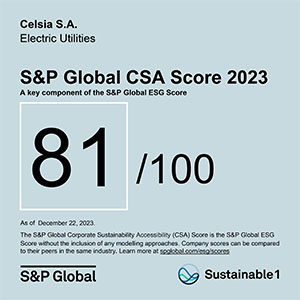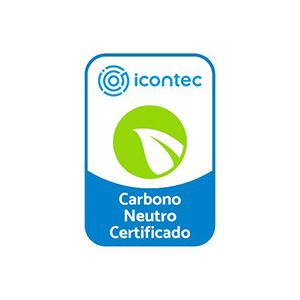We face climate change by taking proactive measures that reduce our carbon footprint and promote a cleaner, safer future.
GRI (3-3) Climate change is one of the main challenges the world is facing today. As an energy company, we are committed to reducing its impact. We act to obtain returns for our shareholders and investors, and we do so with sustainability criteria, hand in hand with our stakeholders, to grow harmoniously and build a better society that ensures the generation of environmental, social and economic value in the long term. We establish strong and trusting relationships to make sure operations have a positive impact.
Our Management
GRI (3-3) TCFD: Strategy – b Our climate strategy is aligned with that of Grupo Argos, in which the pillars of growth are: energy generation with low-emission renewable sources, the energy efficiency portfolio, infrastructure for sustainable mobility and carbon markets. Moreover, we are committed to reducing the impact on climate change by designing effective mitigation and compensation measures, and with innovative actions that contribute to strengthening the capacity for adaptation and developing business opportunities.
To achieve these objectives, we comprehensively identify and manage risks and opportunities, and prepare to mitigate potential impacts. We propose the following measures with respect to mitigation, adaptation, compensation and communication:
Mitigation
- Efficiency actions in operations.
- Energy efficiency
- Using renewable conventional (hydroelectric) and non-conventional (solar and wind) sources.
- A loss reduction in the transmission and distribution system for Valle and Tolima.
- SF6 leak management.
Adaptation
- Installing the hydro-climatological monitoring system.
- Identifying risks and defining business continuity plans to implement solutions based on ecosystems, infrastructure or technology.
- Evaluating assets and investments to minimize disruptions to operations and economic losses for the company.
Compensation
Communications
GRI (3-3) TCFD: Governance – b. We have an environmental policy that incorporates commitments related to managing climate change and other atmospheric emissions, among which we highlight
- Offering a portfolio of low-carbon products and services.
- Improving the operating efficiency of assets in order to manage and control noise and other atmospheric emissions.
- Measuring greenhouse gas (GHG) emissions from operations and implementing measures to reduce the intensity of emissions.
- Incorporating climate change and emissions management variables in the feasibility analyses of new investments and projects.
- Implementing ecological restoration projects for watersheds within the fulfillment of environmental obligations and voluntary projects, such as ReverdeC.
- Reducing the intensity of GHG emissions associated with energy generation by 25% by 2025 (base year 2015) and declaring ourselves carbon neutral with a base year of 2021.
- Integrating the TCFD framework into our risk and opportunity management related to climate change.
Impact of Climate Change
We identify how climate change impacts us on several fronts. We do so to have the information and complete picture to manage mitigation, adaptation and compensation initiatives that lead us to fulfill our environmental goals.
Financial Impact
Financial management includes the characteristics of the ecosystems in which we operate, the conjunctural and structural changes of natural phenomena and their projections in the short, medium and long term, because they affect financial stability due to their impact on assets and changes in power generation levels.
All of the above results from constantly evaluating and monitoring the financial impact of the risks associated with climate change, in order to adopt the necessary measures to guarantee the stability and continuity of our businesses. Failing that, they allow reviewing the strategy or undertaking transformation plans. An example of the above is the El Niño phenomenon, which impacts the operation of the generation assets and the company’s management.
Regulatory Impact
Awareness of climate change has led international institutions and governments to set ambitious objectives for decarbonizing the economy. In Colombia, after signing the Paris agreement, the country committed to reducing GHG emissions by 51% by 2030 and to be carbon neutral by 2050. Moreover, in Central America, there have been positive adjustments in the regulation for self-generation, electric mobility and renewable sources.
This has generated major regulatory changes in the energy sector, framed in the energy transition policy, such as: taxes on fossil fuels, incentives for renewable energies, the economy’s decarbonization, and greater environmental barriers.
We have highlighted challenges generated by Colombia’s strategy on climate change, which seeks to meet the goals agreed upon in the Paris Agreement. Furthermore, new opportunities have arisen in the development of non-conventional renewable energy generation, which is part of our strategy. There are also new opportunities for using hydrogen as an energy vector and industrial input. This issue is also strategic for our organization. We have identified vast potential to grow in electric mobility and energy efficiency for homes, industries and cities.
Impact on the Supply Chain
- Climate change and global dynamics have increased our demands on suppliers, generating trends for selecting them through sustainable purchasing. Moreover, suppliers are more aware of the fact that they can add value through good practices or circular economy initiatives, on which we work together.
- We identify critical suppliers in environmental matters within the supply chain, with whom we carry out training on ESG matters (climate change and carbon footprints), to raise awareness about the changes that are impacting our natural and business ecosystem.
- From a geopolitical point of view, international transportation continues to be impacted which represents an opportunity to reduce imports of materials and encourage developing local trade. This led to a reduction of our carbon footprint. The decrease in imports has also reduced the use of air and maritime transportation. This has been reflected in the country, with a decrease of approximately 12% compared to 2022.
Impact on Customer Management and Experience
We are committed to social and environmental sustainability. Therefore, we have a portfolio of products and services that helps our customers reduce their impact on the environment through projects for the decarbonizing processes and reducing emissions through energy efficiency solutions and self-generation with renewable energies.
On the other hand, our customers require use to carry out preventive and effective actions to ensure the quality and continuity of energy services in light of the effects of phenomena, such as La Niña, or the corresponding energy advice and products to control or reduce energy consumption in light of the El Niño phenomenon.
Impact on Innovation
Mitigating the impact on climate change is one of our main focuses of innovation. Consequently, we are constantly formulating initiatives to reduce greenhouse gas emissions. The products based on NCRES are an eloquent testament to this philosophy, emerging as a concept conceived from the roots of innovation and evolving towards the realization of a massive alternative.
Our initiatives in the field of energy storage, solar power, hydrogen, microgrids and energy efficiency position us as leaders in the exploration of new business opportunities. At Celsia, we encourage the choice of clean technologies in sectors linked to the electrical industry.
We began the search for mechanisms that facilitate integrating energy solutions that seek to establish links between traditional business practices and emerging technological opportunities, generating a positive impact on the environment and improving the quality and efficiency of our services in a balanced way.
In summary, the challenge climate change represents drives us to explore new solutions, in which innovation operates closely to materialize them, thus contributing to creating new market conditions.
GHG emissions
Direct and Indirect GHG Emissions
Our Zero Emissions Goal
starting in 2021 with a base year of 2015.
-
Scope of the goal
Scope 1 and 2 -
Goal validation
Although not validated by the initiative: Science based target: we consider it to be scientifically based, as it is aligned with Colombia’s Nationally Determined Contributions (NDCs).
GHG Emissions Avoided
Emissions intensity and goal
Base year emissions intensity
Emissions intensity target
As a contribution in the fight against climate change, our goal for emissions intensity at the corporate level is as follows:
SASB (IF-EU-110a.3) No recalculation of information has been presented regarding the emissions reduction goal.
To achieve the goal, the growth strategy is mainly based on diversifying the generation matrix with renewable sources, disinvesting in assets with high levels of GHG emissions and prioritizing efficient projects, products and services with a positive impact in terms of climate change. This transformation cuts across all the territories in which we operate and is aligned with international standards for reducing emissions throughout the organization’s value chain.
Risks or limiting factors that may affect achieving emissions reduction goals:
- Regulatory changes that do not facilitate developing low-emission technologies and affect the financial models of the projects.
- Extreme climate variability phenomena that affect the resources we use.
- Failure to obtain environmental licenses for wind and solar projects.
- Limited access to economic or financial resources for project development.
Our emissions reduction and carbon neutrality strategy is voluntary. Therefore, it does not respond to any regulation that limits our emissions with the technologies we currently have.
Since 2015, we have been reporting GHG inventories voluntarily, in line with our sustainability model In addition, we have adhered to local initiatives since 2021, such as carbon neutrality in the Colombian power sector.
Scope 3 Emissions
- Activities related to fuel and energy (not included in scope 1 or 2).
- Waste generated in operations (composting, incineration).
- Business trips.
Celsia has a reliable information management system to collect and extract data, with which it can monitor the performance of emissions in this category.
Click on the tabs for additional details.
Activities related to fuel and energy
(not included in scope 1 or 2).
Source 1
Relevance of the Source for Celsia
Fuel and energy-related activities: They incorporate GHG emissions from the value chain and transportation and distribution, both from electricity imported from the grid and from the extraction and production of fuels used in the organization’s operation. The fuels included are: Diesel, gasoline, natural gas, LPG – propane gas, and fuel oil – Bunker..
equivalents emitted
from suppliers and other actors in the value chain
Scope 3 Emissions Calculation Method
The data reported for these scope 3 sources may vary, as we are in the verification process.
- Through a new technological tool implemented, called environmental variables, we managed to collect the necessary information to calculate the footprint. The Socio-Environmental Management (GSA) team was in charge of reviewing and verifying the information and monitoring the calculation of the carbon footprint for the year 2023.
Waste generated in operations.
Source 2
Relevance of the Source for Celsia
Waste management: It is incorporated into the GHG emissions derived from managing waste generated at the company’s different facilities in Colombia and Central America. The emissions derived from transporting this waste to its disposal site were also included, according to the types defined in the organization (landfill or disposal site, waste dump, incineration and safety cell).
equivalents emitted
from suppliers and other actors in the value chain
Scope 3 Emissions Calculation Method
The data reported for these scope 3 sources may vary, as we are in the verification process.
- Through a new technological tool implemented, called environmental variables, we managed to collect the necessary information to calculate the footprint. The Socio-Environmental Management (GSA) team was in charge of reviewing and verifying the information and monitoring the calculation of the carbon footprint for the year 2023.
Business trips.
Source 3
Relevance of the Source for Celsia
Corporate trips: GHG emissions derived from business trips by the staff of the administrative headquarters in Medellín and Yumbo have been incorporated. These trips are by plane and have been classified into three (3) subcategories: Corporate plane travel (managed by a third party) and domestic and international air travel.
equivalents emitted
from suppliers and other actors in the value chain
Scope 3 Emissions Calculation Method
The data reported for these scope 3 sources may vary, as we are in the verification process.
- Through a new technological tool implemented, called environmental variables, we managed to collect the necessary information to calculate the footprint. The Socio-Environmental Management (GSA) team was in charge of reviewing and verifying the information and monitoring the calculation of the carbon footprint for the year 2023.
Internal Carbon Price
Risks and Opportunities in Light of Climate Change
Scenario analyses
TCFD: Risk Management – a. TCFD: Strategy – b and c. We use quantitative and qualitative scenario analysis for business planning, to identify physical and transition risks with respect to climate. We do this based on different methodologies:
Physical climate risk scenarios
- RCP 2,6.
- RCP 4,5.
- RCP 6.
- RCP 8,5.
- Other climate risk scenarios we have used to measure the probability and impact of physical risk have been through the CAT catastrophic risk modeling carried out by Marsh (the RMS RiskLink and/or AIR Touchstone computational model in which natural threats are analyzed, and the PML [probable maximum loss] is established). Probability Maximum Loss Risks are transferred through the insurance program, which covers material damage, loss of profit and current and future reliability charges suffered by the insured assets due to a sudden and unforeseen natural event.
The assessment is specific according to the context of the physical impacts of climate change for each asset.
Transition Climate Risk Scenarios
Nationally determined contributions (NDCs) of the countries in which we operate:
- Colombia aims to reduce its GHG emissions by 51% by 2030. The Ministry of Mines and Energy defined the following as strategic lines for the sector: generating power (non-conventional sources), energy efficiency (increasing thermal efficiency), and fugitive emissions (petroleum).
- Costa Rica committed to be carbon neutral by 2021 by reducing GHG emissions by 30% and generating 100% renewable energy.
- Panama intends to increase renewable energy to 30% within its electrical matrix. Considering these lines of intervention, we have defined the growth strategy with low carbon emissions by prioritizing the generation of wind, solar and hydroelectric power.
- To measure transition risk, the company uses a stochastic model known as Monte Carlo Modeling to calculate Value at Risk (VaR). Risk analyses using this model consist of replacing variables that have uncertainty associated with unique or specific values for a range of values or probability distributions. The results are then calculated many times, using a different set of values from those initial probability distributions each time. Moreover, the result will not be a single value, but will produce distributions of values of the possible results. Between 2022 and 2023, a transition risk quantification study was carried out to complement our model on the Climanomics platform, with the support of AON and The Climate Service, using a methodology that was fully aligned with the TCFD and the SSP scenarios.
The transition risk assessment is based on possible legislation scenarios, technological development or market conditions and is consistent with the expected useful life of the assets or activities.
Additionally, four Representative Concentration Pathway (RCP) scenarios presented in the Fifth Assessment Report of the United Nations Intergovernmental Panel on Climate Change were modeled. The RCP scenarios provide a range of emissions and concentrations of Greenhouse Gases (GHG) that allow exploring possible future climates more broadly than those used in the past.
TCFD: Risk Management – a. We do this based on different methodologies:
- Our operations.
- Our own operations in initial phases.
- Our downstream operations and customers.
TCFD: Risk Management – b. We rely on the corporate risk management methodology to prioritize climate change risks , which is aligned with good international practices, such as the ISO 31000 standard and the COSO ERM standard. These define similar components based on an understanding of the business, its objectives, environment and trends. Subsequently, the relevant risks are identified and analyzed, and mitigation and adaptation controls are associated, in which the risk is evaluated and treatment is defined. To quantify the risks associated with climate change, the model uses the capabilities of The Climate Service (TCS) through the Climanomics® platform. Its methodology is fully aligned with the TCFD framework and considers a time horizon between 2020 and 2100.
Findings: Risks and Opportunities
GRI (201-2) TCFD: Strategy– a. y c. Risk Management – a. SASB: IF-EU-110a.3 We identify current and potential risks, driven by regulatory, physical and financial factors related to climate change, which may lead to a substantially different direction for our strategy, commercial operations and income and expenses.
Regulatory Risk
Awareness of climate change has led international institutions and governments to set ambitious objectives for decarbonizing the economy, including Colombia. This has generated regulatory changes in the energy sector, framed in the energy transition policy, such as taxes on fossil fuels, incentives for renewable energy, the economy’s decarbonization and greater environmental barriers.
Physical Risk
The main physical risks we face are:
- Drought seasons.
- Floods.
- Sedimentation of reservoirs.
- Erosion of the earth’s surface.
Drought is the main risk because it can result in the inability to generate enough power. Drought seasons in Colombia can vary over decades due to the El Niño phenomenon. Its frequency and intensity are expected to increase with climate change.
Water stress is a minor area of concern for Celsia’s hydroelectric plants due to their location.
Financial Risk
We use financial models and a scenario planning methodology to assess possible financial risks and propose short, medium and long-term management strategies. These models mainly calculate the EBITDA, ROIC, ROCE and Free Cash Flow under horizons that contemplate changes in commercial policy, price variations and quantities in the different energy sales channels. These models also consider the country’s hydrological cycles and extreme weather phenomena, such as El Niño and La Niña, which can positively or negatively affect the expected results. Additionally, we apply a stochastic Monte Carlo simulation model to calculate the Value at Risk (VaR), which is measured as the variation the EBITDA margin may have due to changes in certain variables, such as energy demand, the price of energy on the stock market, and hydrological conditions.
TCFD: Risk Management – b. These risks are mainly managed by applying water source evaluation strategies, reforestation activities through the ReverdeC program which has planted and cared for more than 15.7 million trees and promoting the improvement of hydrographic basins. This translates into conserving water resources, contributing to capturing CO2 and controlling sedimentation in reservoirs.
Additionally, the diversification of the energy matrix with non-conventional renewable sources, energy efficiency, demand management, sustainable mobility, efficient appliances, backup plants and, in general, integrating products and services with low emissions into the portfolio, allows us to mitigate these effects.
Physical risk is currently transferred through the insurance program that covers material damage, loss of profit and the current and future reliability charge suffered by our insured assets due to a sudden and unforeseen natural event. Furthermore, we have business continuity and disaster risk management plans for each one of our assets.
GRI (201-2)TCFD: Strategy – a and c.
Financial Opportunities
Law 1715/14 was established in Colombia to promote, stimulate and promote the development and use of non-conventional energy sources. It includes incentives and tax benefits for companies that invest in renewable energy sources. In Panama, Law No. 45/2004 was issued, which highlights the financing conditions that support us. It also highlights the efficiency of demand based on the change in consumer behavior and energy efficiency.
The revolving loan linked to environmental performance indicators amounting to USD 140 million with the IFC (International Finance Corporation) is still in force. Its performance goal is linked to reducing the intensity of CO2 emissions2 which represents a more competitive rate for the company, stimulates building renewable energy projects and simultaneously leads to considering a possible sale of carbon credits.
and take advantage of the opportunities that may be generated from it, we consider the following relevant topics to work on in the short, medium and long term:
- Tax benefits.
- Carbon markets.
- Tradable quota market.
- Carbon tax.
- Carbon tax. Carbon neutrality.
- Net zero.
- Generation from hydrogen and other alternative sources.
- neration from hydrogen and other alternative sources. Renewable Energy Certificates.
- Sustainable credits: with close to COP 1 trillion in sustainable financing, 20% of our total debt is tied to compliance with ESG indicators. We have financed this matter with Bancolombia (500 billion), the International Finance Corporation (IFC) (275 billion in Green Bonds) and Banco de Bogotá (219.988 billion).
TCFD: Strategy – b Climate change and its respective opportunities have impacts on financial planning in several areas:
Access to capital
Acquisitions or sales:
Capital expenditures and capital allocation:
Costs and operating income
Main Results
GRI (3-3)
We obtained our carbon neutral recertification.
We exceeded the established goal of planting 10 million trees by 2025, by planting 15.7 million between 2016 and 2022.
Technical losses in transmission and distribution for 2023 have had a tendency to decrease due to the start-up of operations of new system expansion works.
We have 18 solar farms in the generation matrix. Six solar farms began operating in 2023: Dulima, Yuma, Flandes, Buga 1, Las Victorias and Palmira 1 in Colombia, contributing to the generation of clean energy. These are: Melgar, San Felipe, Yuma, Dulima y Flandes whose total rated capacity is 69.5 MW for Tolima. Of the solar plants in Valle de Cauca we have Buga 1 of 9.9 MW, the Palmira 3 solar farm, the Victoria 1 and Victoria 2 solar farms each of 19.9 MW.
Regarding SF6 emissions, we had a reduction of 14.5%, thanks to good practices and predictive and preventive maintenance carried out on our assets in operation.
Relevant Fact
Celsia becomes one of the first 50 companies in Panama to receive carbon neutrality certification

Relevant Facts
Celsia becomes one of the first 50 companies in Panama to receive carbon neutrality certification
By 2025
Celsia will submit for approval a target based on the SBTi methodology.
From 2025
onwards, SF6 leakage from Celsia systems will not exceed 1% of the total installed in the year.
By 2030
Celsia will continue to be a carbon neutral company, offsetting all emissions that cannot be mitigated.
Topic / Indicator | Own indicators | CSA S&P Indicator | SASB indicator | GRI indicator | TCFD | External assurance |
|---|---|---|---|---|---|---|
Direct (Scope 1) and indirect (Scope 2) GHG emissions | – | 2.5.1, 2.5.2 | (IF-EU-110a.1) (IF-EU-110a.2.) | 305-1, 305-2 | (Metrics and objectives – c) | |
Scope 3 GHG emissions | – | 2.5.3 | – | 305-3 | – | |
GHG emissions avoided | – | – | – | – | (Metrics and objectives – b) | |
GHG emissions intensity | – | – | – | 305-4 | – | |
GHG Emissions – Climate Goals | – | 2.5.13, 2.5.15 | (IF-EU-110a.3) | – | (Metrics and objectives – b) | |
Internal carbon price | – | 2.5.14 | – | – | (Metrics and objectives – a) | |
GHG Emissions – Climate-Related Goals | – | 2.5.9 | (IF-EU-110a.3) | 201-2 | (Strategy – a, Risk Management – a) | |
Risks from climate change – Physical risks | – | 2.5.9 | – | 201-2 | (Strategy – a) | |
Risks in light of climate change – Financial opportunities | – | 2.5.10 | – | 201-2 | (Strategy – a) |
Direct emissions: Covers direct GHG emissions, which occur from sources owned or controlled by the organization, in the following types of activities: power generation; heat or steam; physical or chemical processes; transportation of materials, products, waste and employees; and fugitive emissions (ISO, 2006).
Indirect emissions: Covers emissions from generating electricity purchased and consumed by the company, which is purchased or brought within the selected spatial boundary (ISO, 2006).
Carbon credits: an international decontamination mechanism to reduce environmental polluting emissions. GHG emissions reductions are measured in tons of CO2 equivalent and are translated into Certified Emission Reductions (CER). Each CER is equal to one ton of CO2 no longer being emitted into the atmosphere and can be sold on the carbon market to industrialized countries. An example of the types of projects that can apply for a certification are: generating renewable energy, improving energy efficiency of processes, reforestation, cleaning lakes and rivers, etc. (Kyoto Protocol).
Science-based targets: Long-term emissions reduction goals aligned with climate science and coupled with the level of decarbonization necessary to meet them.
Nationally Determined Contribution (NDC): Planned reductions in greenhouse gas emissions under the United Nations Framework Convention on Climate Change
Carbon neutrality: Reducing emissions associated with operations and offsetting the remaining CO2, to achieve a balance between those generated and those removed from the atmosphere, to leave the balance at zero neutral..
TCFD (Task Force on Climate-related Financial Disclosures): A framework that guides companies with respect to disclosing information related to the risks and opportunities of climate change and its financial impact.
Non-Conventional Renewable Sources (NCRES): Energy sources based on using the sun, wind, water or plant or animal biomass. They are characterized by not using fossil fuels, but rather resources capable of unlimited renewal.

